#javan rhino calf
Explore tagged Tumblr posts
Text
Two pieces of good news for the Rhinos: a baby Javan Rhino (the most endangered) has been born!
Also, a two-year-old white rhino had a successful surgery on her broken foot.
#javan rhino#javan rhino calf#white rhino#endangered animals#endangered species#rhino#rhinoceros#good news#animals#animal news#endangered rhino
442 notes
·
View notes
Text
#java#good news#rhino#java rhinoceros#javan rhino#environmentalism#science#environment#nature#animals#conservation
39 notes
·
View notes
Text
Critically Endangered Javan Rhino Calf Spotted in the Wild
https://gizmodo.com/endangered-javan-rhino-calf-spotted-in-the-wild-1851394713
View On WordPress
0 notes
Text
[Image Description: greyscale artwork depicting two Javan Rhinos, an adult and a calf, standing in a patch of palm trees. End image description.]

Javan rhinoceros. Last Chance on Earth; a Requiem for Wildlife. Roger A. Caras. Illustrated by Charles Fracé. 1966.
Internet Archive
132 notes
·
View notes
Photo

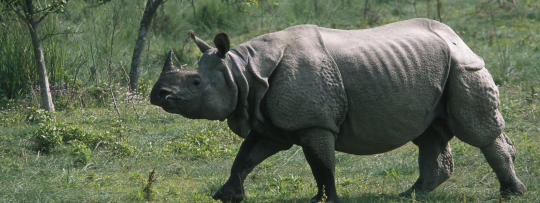
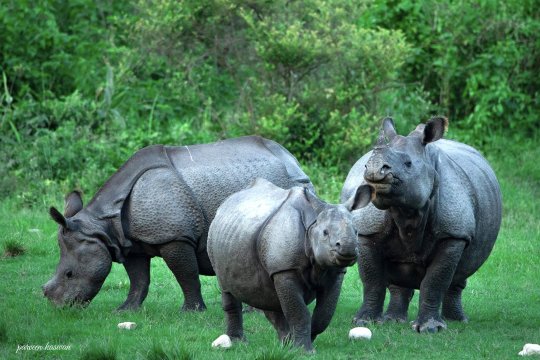
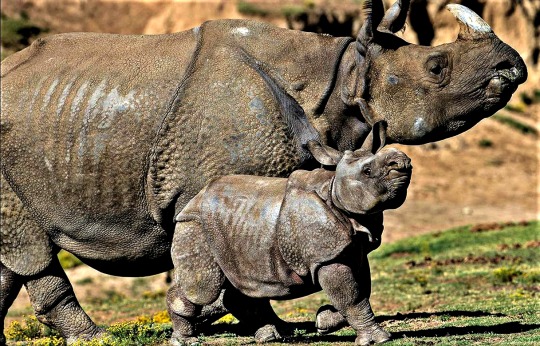
The Indian rhinoceros, also called the Indian rhino, greater one-horned rhinoceros or great Indian rhinoceros, is a rhinoceros species native to the Indian subcontinent where they can be found in a handful of national parks throughout the countries of India and Nepal. The Indian rhino alongside its close relative the Javan rhino make up the genus rhinoceros. Unlike most other species of modern rhino which are typically solitary animals, the Indian rhino can often be found living in social groups of upwards of 6 individuals typically consisting of mothers and there calves as well as subadults, said groups are occasionally accompanied by a bull but as they grow older males grow more solitary in nature. They typically inhabit grasslands, open dry forest, and riverine woodlands where they feed upon grasses, roots, leaves, branches, fruits, and submerged and floating aquatic plants. Because of there size indian rhinos have few natural predators except for tigers and mugger crocodiles which occasionally prey upon young, elderly, or infirm rhinos. Males are typically larger than females standing at upwards of 6ft tall at the shoulder, 12ft in length, and 4,800lbs in weight compared to females at 5ft tall at the shoulder, 11ft in length, and 3,500lbs in weight. This makes the Indian rhino the second largest living rhino species behind the white rhino, and also the second largest land animal in asian behind the asian elephant. These rhinos have a thick grey-brown skin with pinkish skin folds and one horn on their snout. Their upper legs and shoulders are covered in wart-like bumps. They have very little body hair, aside from eyelashes, ear fringes and tail brush. Adult males sport huge armored neck folds. After a 15-16 month pregnancy mother Indian rhinos will typically give birth to a single calf, which will remain by there mothers side for at least 2 years. Females reach sexual maturity sooner than males at around 4 years compared to males a 5 years of age. Under ideal conditions an Indian rhino may live upwards of 40 years.
#pleistocene#extant#living#indian#rhino#rhinoceros#mammal#one#horned#unicorn#horn#great#pleistocene pride
5 notes
·
View notes
Photo

Good news! Two Javan rhino calves have been spotted in Ujung Kulon National Park, Indonesia.🦏🦏This is the last place in the world this species survives and these new additions bring the estimated population up to 73 individuals. Learn more about these conservation efforts at: https://ift.tt/3vy9Go1 #ConservationOptimism Camera trap photo of Javan rhino calf by: Indonesian Ministry of Environment and Forestry https://instagr.am/p/CRJctCqNGdQ/
74 notes
·
View notes
Text
Rhinos in China: Though rhinos are currently extinct in China, here are some new-ish maps and research on the surprisingly widespread distribution of rhinoceros species living in China during recent historic times, prior to large-scale human geoengineering and environmental change
*Spins wheel* Uhhh today’s hyperfixation is: distribution maps, just like every day. But this time, it’s maps related to East Asian environmental history and the anthropogenic extinction of rhinos. Or whatever. Have this stupidly long and completely unsolicited post, I guess.
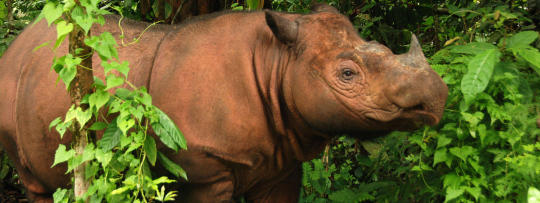
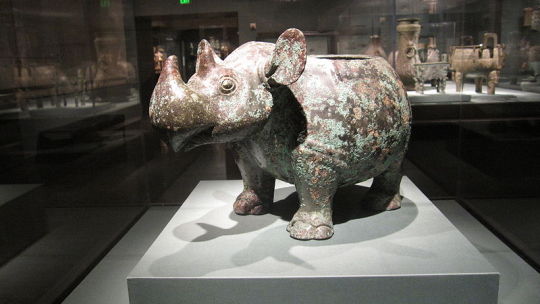
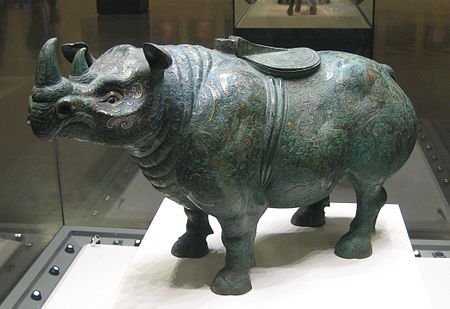
Today, rhinos are extinct in China. The presence of rhinos in China during historical times - and the scale of their distribution range - has been a bit ambiguous, at least to Western/European audiences, though Chinese art and scholarship has long incorporated rhinos. Though modern, living rhinos seem to be associated with tropical and subtropical biomes in the popular consciousness, the Sumatran rhinoceros (Dicerorhinus sumatrensis) apparently didn’t mind the seasonal snow and cold of temperate climates. About only 3,000 years ago, the Sumatran rhino was apparently still present throughout most of China, as far north as modern Beijing; even as recently as 100 AD, this rhino was probably still present as far north as Shanghai.
The phrase “retreat of the elephants” has sometimes been used to describe the process of human-caused environmental change and landscape alteration that dramatically remade the Chinese landscape over the past 3,000 years especially. (”Retreat of the elephants” is a term borrowed from environmental historian Mark Elvin.) It is relatively well-known that Asian elephants (Elephas maximus), which at the beginning of major Chinese state-building and irrigation projects about 3,000 years ago still lived as far north as Beijing, were gradually driven further and further south, away from the Yellow and Yangtze rivers. Recent research, though, shows that Sumatran rhinos also suffered a similar fate. A “retreat of the rhinos” if you will.
The two rhinoceros figurines pictured above are pieces from ancient China. The first image is in the public domain and depicts a rhino-shaped ritual wine vessel made of bronze, from about 1100 to 1050 BC, during the Shang era. The piece is housed at the Asian Art Museum of San Francisco, The second image is another bronze wine vessel from a site in Shaanxi Province, this time inlaid with gold and hailing from later in history during the Western Han period, about 205 BC to 10 AD. [Photo by Wikimedia user Babel/Stone.] The rhinos in both of these pieces are depicted with two horns, meaning that they likely depict the Sumatran rhinoceros; this is corroborated by the existence of fossil remains of Sumatran rhinos from across China prior to 1000 AD. [The header photo above depicts a living Sumatran rhino on the island of Sumatra. Photo by Bil Konstant and International Rhino Foundation.]
Here behold a Sumatran rhino - and a calf! [At Sumatran Rhino Sanctuary on the far southeastern edge of the island. Photo by S. Ellis, via PBS.]
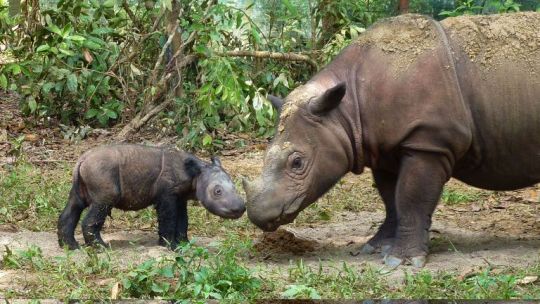
A Sumatran rhino. [Photo by Mark Carwardine and WWF.]
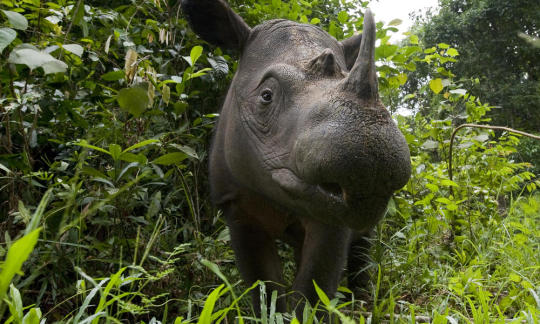
-
Here are some maps and other recent research resources about 3 of the rhinos living in China in recent history.
At the end of the last Ice Age of the Pleistocene about 11,500 years ago and during the advent of so-called agricultural civilization, China was apparently still home to at least 3 species of rhino: the woolly rhinoceros (went extinct around this time); Javan rhinoceros; and, by far the most widespread species, the Sumatran rhinoceros. (To be fair, it is proposed that a 4th species - the famous Indian rhinoceros, Rhinoceros unicornis, now the most relatively stable of the Asian rhino species - was potentially historically present in small pockets of China’s Yunnan Province up until the 20th Century.)
(Rhinos don’t observe arbitrary human-made national borders. I don’t like observing national borders especially when discussing biogeography and ecoregions, so here I’m referring to “China” as the geographic space which was in the cultural sphere of influence of a Chinese dynasty/state between the Shang era and the early 20th Century; centered on the Yellow and Yangtze rivers; and basically including landscapes north of Vietnam, east of Tibet/Taklamakan, and south of the Gobi Desert.)
-
Woolly rhinoceros (Coelodonta antiquitatis)

This is a reconstruction of a woolly rhinoceros, housed at the Natural History Museum in London. Photo by Emoke Denes.
Here’s a distribution map of known sites where woolly rhinos still lived in the Late Pleistocene (up to about 11,500 years ago), at the time that humans were planting and domesticating food crops.

This map comes from a neat report on Late Pleistocene megafauana and ecology in China: “Three abrupt climatic events since the Late Pleistocene in the North China Plain” from Lin Jingxing et al., 2013.
Woolly rhinos may have died out around this same time at the end of the Pleistocene (11,500 YBP), a little too early to have been depicted widely in Chinese art. (Some radiocarbon dates of woolly rhino remains in nearby Siberia, however, suggest the rhino could have persisted into the Holocene until the climatic reversal of the Younger Dryas period, about 10,000 YBP or 8,000 BC.)
-
Javan rhinoceros (Rhinoceros sondaicus)
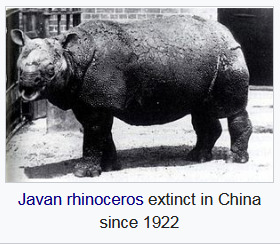
[Thank you, Wikipedia.]
There are less than 100 Javan rhinos that still exist, living only in Ujung Kulon National Park on the far western tip of Java. Here’s the distribution range of the Javan rhinoceros in recent history before its terrible decline [map by Wikimedia user JayHenry]:
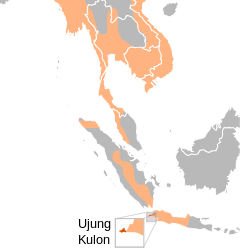
During the past 150 years, the Javan rhino still lived all across Southeast Asia, from India and Bangladesh through Vietnam and into Indonesia. Historically, the Javan rhino likely used to live along the southern China coast west of Guangzhou and Hong Kong. Since the species seems to prefer humid tropical environments, it’s unlikely that the Javan rhino lived any farther north into China during historic times.
-
Sumatran rhinoceros (Dicerorhinus sumatrensis)
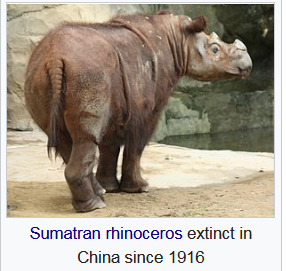
[Thanks again, Wikipedia.]
Here we are. Unlike other rhino species which either went extinct during the Pleistocene or only occupied the humid, tropical southern fringes of China, the Sumatran rhino lived throughout most of China. This is the species likely depicted in historic Chinese art and from which rhino-hide armor was made. Occasional poems from early China also seemingly make reference to the presence of rhinos.
Here’s the current distribution of the Sumatran rhinoceros, contrasted with the early 20th Century distribution [map by Wikimedia user Jay/Henry, adapted from Foose 1997 and Dinerstein 2003]:

Note that the Sumatran rhino currently lives nowhere near China. Until 1916, the Sumatran rhino had lived in Yunnan Province in far southern China along the Myanmar and Indian borders with China. This map is misleading, however, since the Sumatran rhino was present across the majority of China during “historic” times. Recent Chinese scholarship confirms that the Sumatran rhinoceros was much more widespread across China before 1000 AD.
During the past 3000 years, the Sumatran rhino evidently lived as far north as Beijing, in northern China. Here’s a map of recovered Sumatran rhino fossils throughout China, including an approximation of their distribution range over time.
The real historic distribution of Sumatran rhinos in China:
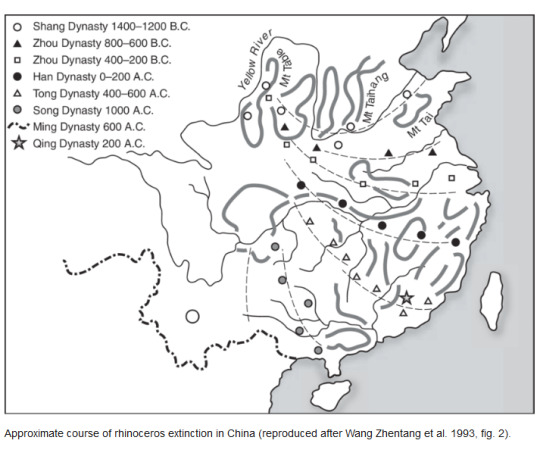
I edited the map a little:
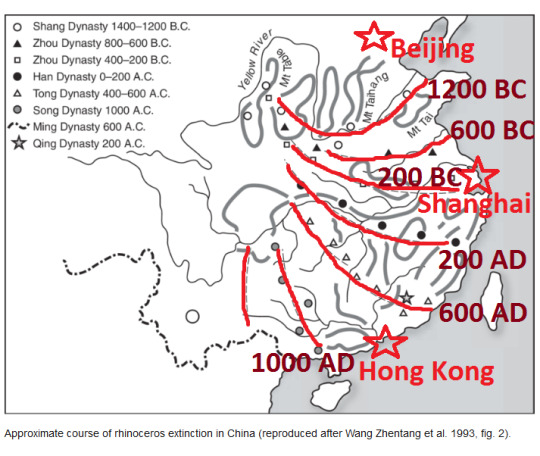
During the Shang era (1400-1200 BC), Sumatran rhinos were still present near Beijing and the Yellow River. By the famous Han Dynasty and the so-called unification of a Chinese “empire” around 50 AD, Sumatran rhinos had been pushed south to about the Yangtze River and Shanghai. By about 1000 AD, the species had been pushed farther south, near Guangzhou and Hong Kong.
This map uses fossil presence of Sumatran rhinos to approximate the historic extent of their distribution in China. The map comes from a great summary of the historic distribution of rhinos in China: “Distribution and extinction of the rhinoceros in China: review of recent Chinese publications” from Kees Rookmaaker, published in Pachyderm, 2006.
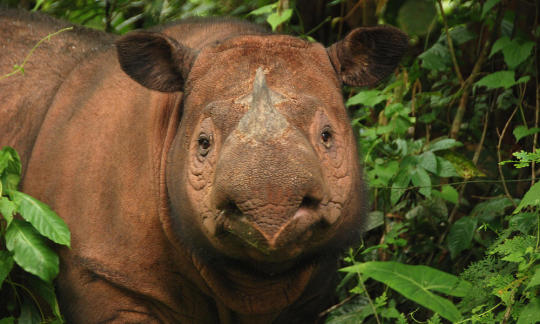
[A Sumatran rhino. Photo by Sumatran Rhino Sanctuary via WWF.]
Check out this link to read more about the history of rhinos in China.
Thank you for participating in this hyperfixation.
117 notes
·
View notes
Photo

Workshop tidy up time. Few jobs finishing off this week. Giraffe, replica Javan rhino head , two headed calf and replica black rhino horns. #workshop #taxidermy #giraffe #rhino #modelmaking (at Animatronic Animals ltd) https://www.instagram.com/p/B7kqEMVJC9h/?igshid=p9gbxnxm5575
1 note
·
View note
Photo

Javan rhino (Rhinoceros sondaicus) and calf
3 notes
·
View notes
Link

Photo: Tammy Spratt, photographer/San Diego Zoo Safari Park
Excerpt:
A southern white rhino named Victoria at the San Diego Zoo Safari Park is expecting, and while any pregnancy is reason to celebrate, this one has the potential to save an animal essentially poached out of existence.
If her pregnancy through artificial insemination is successful, it could be a significant step in helping the northern white rhino recover.
Only two northern white rhinos, a distant subspecies, are alive; both are female but they cannot bear a calf. The last northern white male rhino, named Sudan, was euthanized in March at a preserve in Kenya due to age-related health problems.
Researchers hope that one day Victoria could serve as a surrogate mother, giving birth to a northern white rhino baby. They're optimistic that a northern white calf could be born this way within 10 to 15 years, and the work could also be applied to other rhino species, including critically endangered Sumatran and Javan rhinos.
"The confirmation of this pregnancy through artificial insemination represents an historic event for our organization, but also a critical step in our effort to save the northern white rhino," said Barbara Durrant, Ph.D., director of reproductive sciences at the San Diego Zoo Institute for Conservation Research.
Victoria is one of six female southern white rhinos relocated to the San Diego park from private reserves in South Africa. The San Diego Zoo Institute for Conservation Research is conducting tests on all of them to see if they would be successful as surrogate mothers.
The zoo institute has the cells of 12 individual northern white rhinos stored at its "Frozen Zoo." Scientists hope to convert those preserved cells to stem cells, which could develop into sperm and eggs to be used to artificially inseminate the female southern white rhinos.
2 notes
·
View notes
Text

Meet the Danish-Swedish Farmdog, AKC’s Newest Recognized Dog Breed
See more
See more
#oceania#papua#west papua#new guinea#wildlife#mammal#mammals#monotreme#monotremes#echidna#echidnas#animal facts#animal news#mammalogy#natural history#my stuff#husky#great pyrenees#dogs#puppy#my dog#ok to rb#animels#cuddle#javan rhino#javan rhino calf#white rhino#endangered animals#endangered species#rhino
1 note
·
View note
Text
Javan Rhinoceros
#FaunaFocus The Javan rhinoceros' gestation and inter-birth intervals are unknown, but are presumed to be similar to other rhinos, with a single calf being born after a gestation of 15-16 months every 2-3 years. #JavanRhino #JavanRhinoceros
The Javan rhinoceros’ gestation and inter-birth intervals are unknown, but are presumed to be similar to other rhinos, with a single calf being born after a gestation of 15-16 months every 2-3 years.
The Javan rhinoceros’ gestation period is unknown, but is presumed to be approximately 15-16 months, as in other rhino species, like the closely related Indian rhinoceros (Rhinoceros unicornis), or…
View On WordPress
0 notes
Photo

Rhinoceros
This blog post is about the rhinoceros. After the elephant, rhinos are the largest mammals on Earth. They can grow up to twelve feet long and six feet tall. Rhinos can weigh anywhere from 1,300-7,000 pounds. There are five known species of rhino, two being African and three being Asian. The African species can be white or black and have two horns. Asian rhinos include the Indian and the Javan, which each have one horn, and the Sumartan which has two. They are herbivores and prefer to graze on grass or eat the foliage of trees or bushes.
A rhino’s habitat can vary anywhere from dense forests to savannas. The reproduction process consists of the males and females frequently fighting during courtship. This can sometimes lead to serious wounds inflicted by their horns. After the mating process, the pair goes their separate ways, leaving all young (known as calves) fatherless. Fourteen to eighteen months after the mating occurs, a calf is born. They nurse for up to a year, however, they begin eating vegetation one week after birth. Their lifespans in the wild are typically up to thirty-five years.
Rhinos currently rank among the most endangered species on Earth. As they are valued for their horns, they face a dire threat from poaching, which is also pushing them towards extinction at a rapid rate. Their horns are used for jewelry, dagger handles, as well as traditional Chinese medicine. These horns have become so valuable on the black market that criminals have been stealing them from museums. Hunting has also broken some species down into disconnected groups, making the rhinos unable to breed and continue adding genetic diversity to the species.
One specific species that has been greatly effected by these threats is the Northern White Rhino. This subspecies of the rhino has been completely wiped out, and none of them remain in the wild. However, five are currently left in captivity. As a result, this species faces certain extinction. The United States is currently the second largest consumer of illegal wildlife products in the world, so decreasing the demand at home can have a great impact on wildlife, even halfway across the globe. Currently, the Defenders of Wildlife is working on Capitol Hill to fight legislative efforts to weaken the Endangered Species Act and the protections for the rhinos that come with it. They are also fighting for more law enforcement to keep poached rhino horns from being smuggled into the United States. (Facts about Rhino 2017)
Basic Facts About Rhinoceroses. (2017, September 28). Retrieved from https://defenders.org/rhinoceros/basic-facts
Photo: http://www.facts-about.info/northern-white-rhinoceros/
0 notes